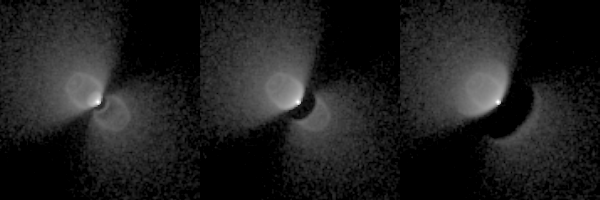
Here are some data and models for this source.

Figure 1. Data on HL Tau. The top left panel is an HST WFPC2 image at V-band (Stapelfeldt et al. 1995). The others are adaptive optics near-IR images from Close et al. (1997). The top right image is at J-band (1.25 microns), the bottom left is at H (1.65 microns), the bottom right is K (2.2 microns).

Figure 2. Model images at the four wavelengths (V,J,H,K) to compare with Figure 1. The model consists of a small, (40 AU) flared disk and an envelope with about 1/10 the mass of a typical protostellar envelope (For a TSC envelope, the infall rate is 4 x 10^{-6} solar masses/yr). The envelope has a wind-blown bubble in it, generated by hydrodynamical calculations of Guy Delemarter and Adam Frank. The object is viewed at an inclination of 53 degrees (cosi=0.6). At more edge-on inclinations (cosi < 0.6), the backscattering lobe (bottom right of each image) is too bright in the V image. For the disk to obscure the star at this inclination, it is flared according to z~r^{5/4}, which is steeper than the canonical value (z~r^{9/8}) but within limits of reasonable values (Kenyon & Hartmann 1987). The flared disk causes shadowing which leads to a highly bipolar structure that is not seen in the data of Close et al. (1997). The V-band model was convolved with the HST PSF, and the JHK models were convolved with a 0.2" Gaussian.

Figure 3. On the left is the same V-band model as in Figure 5 shown at full resolution (0.455"/pixel). This includes a 40 AU radius disk as described in Fig. 5. The middle panel shows our best fit model for a disk size of 80 AU, and the right panel shows the same for a disk size of 160 AU. In all of these models, the disk flaring and inclination were chosen to give the best fluxes and image morphology. In fact, the fluxes are all in good agreement with the data. However, it is clear from these that a large disk is distinctive at all wavelengths. NICMOS imagery will be very useful in helping to determine if a flared disk is the source of the optical extinction and if so, how big it is.
Now we're revisiting the protostar models that have larger envelope mass. It seems the flared disk is not seen in the observations.